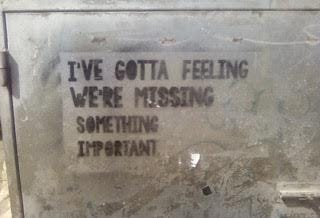“Even ifs have breath when empty tombs do not. Even ifs laugh or sob with me or tap me on the shoulder, as you do this minute now, my rational friend …”

Such a Beautiful Tomb
One day someone told me a story. It was a story from the Bible. I don’t know if you’re familiar with many stories from the Bible, you being the modern that you are, but the story went like this:
A rabbi had been violently executed by the presiding regime and his body was laid in the ornate mausoleum of a wealthy philanthropic synagogue-goer who hoped the donation of his family plot might do him some spiritual good somewhere along the line. The sentimental women who loved to go around indulging in grandiose sobbing in front of a fancy tomb after a ghastly death and emotional funeral, went around sobbing in front of this one. But alas! the rabbi did not stay dead. He recovered from being dead, took off his shroud and went off to have a nice breakfast of eggs and no bacon with his men friends, so all the wailing women got up, went home, and cooked eggs and no bacon for their hubbies too.
All but one, who couldn’t bear to tear herself away. The number-one sentimental woman was much more dedicated than any of the others and had been so busy bawling away in front of the philanthropist’s crypt, she failed to notice the wide-open door, the sepulcher all spick-and-span like it was brand-new, not even a funky smell, the absence of her companions. No one was in the vault at all. Someone, an angel actually, since everyone else had left, eventually had to come over and tap on Miss Love-a-Good-Tragedy-Don’t-Mind-If-I-Do’s shoulder to say, “Excuse me, Ma’am, this grave is empty. What are you crying about? Isn’t it time you went home?” It wasn’t that she’d mixed up the plot numbers and was at the wrong site. The dead man had simply got up and left and in all her beautiful heartfelt lamentations for the dear departed rabbi, she hadn’t even noticed.
That is the story I was told. It was appended with the comically cryptic saying, “Return to the empty tomb to find your hope again.”
Yes, a graveyard — charming place to look for hope, was my feeling. I was never a goth. I never listened to death metal. I didn’t hang out in graveyards as a teenager to smoke pot. Some of the kids did, but not my crew. We went to Queens Gardens instead.
The rationalist in you would say, “There can be no hope in an empty tomb. If there is anything at all in the empty tomb, the tomb is no longer empty.”
The point of the story is — yes, of course there is a point to it, you can’t have a story about a dead rabbi who gets up and walks away without there being a point — the point of the story is that many of us women, probably men too, but I’m not one so don’t presume to speak on your behalf: half of us women, myself as guilty as any, spend much of our lives mourning the deaths of things that aren’t even buried but are up walking around eating breakfast. Many of the burials I’ve given, I’ve noticed, were for things that never existed in the first place. Dreams that never took place. Relationships that foundered before they even began. Most recently, children I never conceived, let alone gave birth to.
You’d think, but then you’re a rationalist so you would think this, you’d think the fading of dreams would give me an astonishing amount of freedom, that I’d be able to look around and say, “The future is wide open. Everything is before me. The whole world awaits. Such-and-such did not work out for me, therefore onward! Ho!” But no, instead I sit around sobbing, too busy being bereaved to notice what bright sunshine pours down around me, too busy burying my dead fantasies over and over again, moaning that the man who left me was not the man I’d thought, wailing over the paragon of integrity I believed in who had never existed.
You’d think, but then you have ever been more rational than I, that I would pause to look up and notice the grave’s vacancy, the glorious sunny day outside, and go off to cook my own sodding breakfast, happy that there were nothing in my arms left to bury, but instead I carry on carting these bizarre, malformed shades back to my private cemetery. Every time I notice the empty tomb, off I go to summon up another wraith and attempt to bury it yet another time, and round it goes again. I hold perpetual funerals for illusory hopes that neither stay buried nor ever really die and yet do not live nor take breath either.
I do know, as well as you, that every plan crumpling ahead of me and every wispy dream I bury, is in fact my freedom from bondage to that dream, new opportunity for tangible hopes to live, to take breath inward — and so much surrounds me in the present, even if only a cat or a roommate. Even if only a word processor. Even if only a friend to cook dinner for. Every even if of my life is so much greater than the nothings I wail and sob about in front of the tomb. Even ifs have breath when empty tombs do not. Even ifs laugh or sob with me or tap me on the shoulder, as you do this minute now, my rational friend, saying, “Excuse me, why are you grieving? This tomb is empty. Isn’t it time you went home?” And why am I still crying, really?
I wasn’t told what the woman in the story did after the friendly angelic shoulder-tap but I imagine, sentimental as she was and much like me, she looked back sadly and, sighing, said, “Not dead? The pity! He had such a lovely funeral, and O, it’s such a beautiful tomb.”

************************************************************************************************

Charlotte Simmonds is a writer, translator, and theater practitioner. In her native New Zealand, her work has been produced in theaters and podcasts, and it has appeared in literary journals. In the U.S., she has published in The Iowa Review, Mid-American Review, Painted Bride Quarterly, and Broad Street. Her poems and short prose are collected in her book, The World’s Fastest Flower.
Charlotte’s lyrical essay about the art of beatboxing,“Ki-paw-paw-pish!,” appeared in Broad Street’s “Hunt, Gather” themed issue and is available for reading on the web. To find out what she has to say about telling stories and speaking truth, read her Truth Teller Spotlight.
Author photo by Magda Barthofer.









